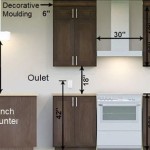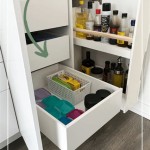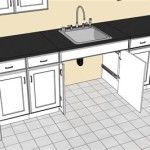How To Remove Paint From Kitchen Cabinets
Kitchen cabinets are the heart of the kitchen, and their appearance can significantly impact the overall aesthetic of the space. Over time, painted kitchen cabinets may chip, peel, or become outdated, necessitating a fresh coat of paint or a complete makeover. Removing existing paint from kitchen cabinets can be a daunting task, but with the right approach and tools, it can be accomplished effectively and efficiently. This article will explore various methods for removing paint from kitchen cabinets, providing a comprehensive guide for homeowners and DIY enthusiasts.
1. Assessing the Paint and Cabinets
Before embarking on the paint removal process, it is crucial to assess the type of paint and the condition of the cabinets. Understanding the nature of the paint will determine the best removal method. Older cabinets may have multiple layers of paint, requiring more aggressive techniques. Similarly, the material of the cabinets, whether wood, laminate, or another material, will influence the choice of removal methods.
For example, oil-based paint, known for its durability, may require stronger chemicals, while latex paint, more common in modern homes, can be removed with gentler approaches. Inspecting the cabinets for any damage, such as cracks or warping, is also essential, as these issues may affect the paint removal process and require additional steps for restoration.
2. Preparing the Work Area
Creating a safe and organized work area is paramount for successful paint removal. This involves clearing the surrounding area of any obstacles and protecting surfaces that may be affected by paint remover or debris. Cover countertops, floors, and appliances with drop cloths or plastic sheeting to prevent damage or staining. Proper ventilation is also essential as paint removers often release fumes that can be harmful.
Ensure adequate lighting, as you will be working with small details and potentially hazardous materials. Having a well-equipped workspace with tools readily available, such as paint scrapers, brushes, and containers, will streamline the process and minimize interruptions. It is also advisable to wear protective gear, including gloves, goggles, and a mask, to safeguard your skin and respiratory system from harmful chemicals.
3. Choosing the Right Removal Method
Several methods exist for removing paint from kitchen cabinets, each with its advantages and disadvantages. The chosen method should be tailored to the specific paint type, cabinet material, and your comfort level with different techniques. Here are three common methods:
a. Chemical Strippers
Chemical strippers are powerful solutions that dissolve paint, making them a popular choice for removing multiple layers or stubborn paint. They are available in gel, liquid, and paste forms, each with its application methods. Gel strippers are effective for vertical surfaces due to their ability to cling, while liquid strippers are well-suited for flat surfaces and provide quicker results. Paste strippers offer a thicker consistency that allows for controlled application and prevents dripping.
Despite their effectiveness, chemical strippers can be harmful if mishandled, so it is crucial to follow the manufacturer's instructions carefully. Wear protective gear and ensure adequate ventilation. Remember to test the stripper on a small, inconspicuous area of the cabinet before applying it to the entire surface. Allow the stripper to work according to its instructions, and then scrape off the softened paint with a scraper or putty knife. Be cautious as the paint will become soft and may be messy.
b. Heat Guns
Heat guns are another effective option for removing paint. They use concentrated heat to soften the paint, making it easier to scrape off. This method is particularly suitable for removing layers of paint without damaging the underlying surface. Adjust the heat setting of the gun according to the type of paint and cabinet material. Start by testing the heat gun on a small area to ensure it doesn't damage the wood. Once the paint softens, scrape it off using a scraper or putty knife. Be cautious as the heat gun can become very hot and may cause burns.
Heat guns are generally faster than chemical strippers, but they may require more time to remove multiple layers of paint. This method is also not suitable for certain surfaces, such as laminate or painted finishes that may be sensitive to heat. Exercise caution when using heat guns and avoid exposing them to any flammable materials.
c. Sanding
Sanding is a more time-consuming method but is gentler than chemical stripping or heat guns. It is particularly useful for removing thin layers of paint or for preparing cabinets for a new coat of paint. Use sandpaper with varying grits, starting with a coarser grit to remove the majority of the paint and finishing with a finer grit to smooth out the surface. Use a sanding block or orbital sander to ensure even sanding and minimize the risk of scratching the wood. Be cautious with pressure, as excessive pressure can damage the cabinet's surface.
Sanding can generate dust, so it is crucial to wear a dust mask and provide adequate ventilation. Use a tack cloth to remove any remaining dust particles before applying any new paint or finish. Ensure the sanding process is thorough and removes all traces of the old paint before proceeding to the next step. While sanding can be effective, it may not be suitable for removing multiple layers of paint efficiently.
4. Cleaning and Refinishing
Once all the paint is removed, thoroughly clean the cabinets using a damp cloth and mild detergent. Remove all residue from the paint remover or sanding dust to ensure a clean and even surface for any subsequent finishing steps. Allow the cabinets to dry completely before proceeding.
You can now choose to refinish the cabinets with a new coat of paint, stain, or other finishes, depending on your design preferences. If using paint, ensure it is compatible with the surface and apply it according to the manufacturer's instructions. For a stained finish, apply a wood conditioner to ensure even color absorption. Regardless of the chosen finish, allow the cabinet to dry completely before using them again. With careful preparation and proper execution, removing paint from kitchen cabinets can be a rewarding project, transforming the look of your kitchen and enhancing its overall appeal.

How To Strip Paint Off Kitchen Cabinets And Furniture

An Easier Way To Remove Paint From Wood

An Easier Way To Remove Paint From Wood

How To Strip Paint Off Kitchen Cabinets And Furniture

How To Strip Paint Off Kitchen Cabinets And Furniture

How To Strip Paint Off Kitchen Cabinets And Furniture

How To Strip Paint Off Kitchen Cabinets And Furniture

Removing Paint From Kitchen Cabinets Chemical Stripper Vs Heat Gun Methods

An Easier Way To Remove Paint From Wood

My Cabinets Are Ling Is There Any Kind Of Paint I Can Use In Them Hometalk
Related Posts








